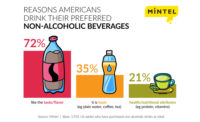Maturing US Organic Sector Maintains Steady Growth
Organic Trade Association survey puts 2017 organic growth rate at six times the pace of overall food market

American consumers in 2017 filled more of their grocery carts with organic, buying everything from organic produce and organic ice cream to organic fresh juices and organic dried beans, according to the Organic Trade Association’s 2018 Organic Industry Survey released on Friday.
Organic sales in the US totaled a new record of $49.4 billion in 2017, up 6.4% from the previous year and reflecting new sales of nearly $3.5 billion. The organic food market hit $45.2 billion in sales, also breaking through to a new record for an increase of 6.4%. Sales of organic non-food products rose by 7.4% to $4.2 billion, setting another new benchmark.
The growth rate for organic food sales was below 2016’s 9% pace and was impacted by markedly slow growth in the big organic dairy and egg category. However, it was well above that of the overall food market, which nudged up 1.1%. Organic continued to increase its penetration into the total food market, and now accounts for 5.5% of the food sold in retail channels in the US.
“Organic has arrived. And everyone is paying attention,” said Laura Batcha, CEO and Executive Director of the Organic Trade Associaion. “Our survey shows there are now certified organic products in the marketplace representing all stages of the life cycle of a product or a company—from industry veterans to start-ups that are pioneering leading edge innovation and benefits and getting shelf space for the first time. Consumers love organic, and now we’re able to choose organic in practically every aisle in the store.”
This year marks the 20th year of the Organic Trade Association’s survey. The survey, widely regarded as the most comprehensive look at the retail organic sector in America, first measured organic sales in 1997. That year, organic food sales were pegged at $3.4 billion; 2017’s sales of over $45 billion reflect a growth of nearly 15 times. In the last decade alone, the US organic market has more than doubled in size.
The organic sector has thrived since the advent of a strict, comprehensive federal standard for organic and the introduction of the organic seal in the marketplace. In 1990 when the Organic Foods Production Act was signed into law authorizing the US Department of Agriculture’s National Organic Program, US organic sales totaled just $1 billion. By 2002 when the final federal organic standards were implemented and the USDA Organic seal was introduced, organic sales had climbed to $8.6 billion. Fast forward to the present, and you see over 24,000 certified organic operations nationwide serving an almost $50 billion market, whose annual growth rate regularly outpaces that of the total food market.
While the growth in organic sales slowed in 2017, some slowdown in what had been an on-fire growth pace was expected. The organic market is maturing and coming of age. New channel and product expansions are becoming more incremental rather than revolutionary. Organic’s market performance revealed the maturity or different stages of development of each category in organic food, plateauing in some areas and shifting in others to reflect new trends and challenges.
Looking for a reprint of this article?
From high-res PDFs to custom plaques, order your copy today!







